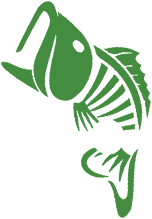Wet Fishing | Fishing Wet Flies
When you’ve been fishing wet flies almost your entire life, you sometimes forget how hard it is to master the technique. Fishing wet flies may look easy, but the devil is in the details.
However, with the right skillset, wet flies are the simplest and most effective ways to catch trout, bass, and other types of river fish.
Wet Flies vs. Dry Flies: What’s the Difference?
The other day, while fishing with my son, he turns to me and asks, “Why do we always fish wet flies? Why don’t we ever use dry flies?”
I was taken aback for a minute. But, then I realized that there’s so much talk these days about dry fly and nymph fishing that many people have forgotten about the classic, and arguably the most effective, method of river fishing.
While the most apparent difference between wet and dry flies is that one floats and one sinks, there are other relevant distinctions. For starters, dry flies are typically smaller, while wet flies can be larger and catch bigger fish.

Dry Flies
Dry flies float on the surface of the water, representing grown aquatic or terrestrial insects. They are typically small and don’t look like much, attracting fish more because of movement than appearance.
Dry flies are designed to land softly on the water, attracting fish as they float downstream. The problem with this kind of fishing, or nymphing, is that your line has a tendency to become snagged, and it’s very easy to break off flies.
Wet Flies
Wet flies are designed to resemble actual insects. They are generally more colorful than dry flies and act like a drowned insect that has fallen in the water. Some are also built to sink below the water’s surface, where larger fish may lurk in recesses beneath the rocks.
Many wet flies are brightly colored to make them easy for fish to spot. They may incorporate some sort of weight, achieved with a bead head, copper wire, and water-absorbent fly tying materials. Wet flies are intended to impress and entice fish to bite.
Wet Fly Fishing Gear You’ll Need
The gear setup for fishing wet flies is simple and easy. You don’t need big indicators or have to worry about dry fly floatants.
For tying flies, it’s best to use long, wispy, and stringy materials. More extended hackle collars and bulkier dubbing fibers can help your fly to move the water more effectively.
As far as rods are concerned, a 9-foot rod with a weight of 5 or 6 is an excellent place to start. Of course, you can adjust your rod weight depending on the size of the fish you intend to catch.
Other gear you’ll need includes:
- Fly rod
- Fly line
- Fly reel
- Backing (around 100 yards)
- Leader and tippet
- Wet flies

How to Achieve a Wet Fly Swing
Once you’ve found a good run, you’ll want to position yourself for success. Look for a location with a steady current and a riffle-like pattern in water that isn’t too deep.
If you’re not sure where the fish are, casting in a systematic pattern is the best way to begin. Then, follow these steps until you’ve finished the run.
- Often, especially in large rivers, the fish may be closer than you think. It’s easy to miss fish floating in shallower regions heading out to deeper water. For this reason, begin by covering the water closest to you.
- Cast across the water at a 45-degree angle, going downstream.
- Your goal should always be to ensure that your fly is presenting naturally to the fish. Mend your line as you go, keeping the speed of your fly under control and limiting drag.
- Maintain a tight line so that you will feel if a fish is interested.
- Once the current has taken your line, let it dangle for a few seconds before picking it up again for another cast. This is often the moment when a fish will take the fly, so be ready.
- Assuming there was no action on the cast, take a step or two downstream, pick up your line, and make another cast at a 45-degree angle.
- Continue these steps until the run is complete.
Tips for Mastering Wet Fly Fishing
As I mentioned earlier, it’s easy to get started fishing wet flies, but challenging to master. Small things can make a big difference. So, I’ve put together a few tips I’ve learned over the years to help you catch the big one.
Casting Tips
For starters, when casting, keep your rod tip low and follow your fly across the swing.
Also, when needed, be sure to mend your line for a more natural swing and to ensure your fly drifts in the most enticing way possible.
Then, when you reach the end of your line, always let your fly dangle for a few seconds, or “hangle down.”
Add Flash to Your Flies
If you’re having trouble, you can also try adding a little flash to your flies.
Bright purples and pinks seem to attract fish, as well as UV, to mimic the phosphorescence of many insects.
Use a Tandem Fly Setup
Some have had success with a tandem fly setup. This technique involves adding a second fly for additional enticement for fish.
Find the Pockets and Stick With Them
After you’ve finished a run, you’ll likely have a good idea where to find the pockets (or buckets). If they seem promising, try sticking with them and see what you can catch before moving on to the next run.
Final Thoughts
Fishing wet flies is an excellent way to cover water. Not only are they the most effective method for catching trout, but they are also a lot more fun to cast than a streamer rig or weighted nymph.
Next time you’re in the mood for a little fishing (which, if you’re like me, is all of the time), consider going with a classic technique. It’s a whole lot more enjoyable than watching a strike indicator float down the river.




